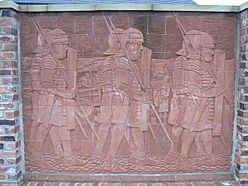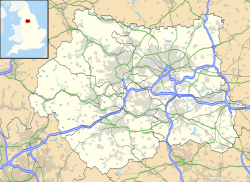Lagentium facts for kids
Quick facts for kids Lagentium |
|
|---|---|

Modern tile mosaic illustrating Castleford's Roman history
|
|
| Alternative name(s) | Legiolum |
| Founded | c. 74 AD |
| Abandoned | 180 AD |
| Place in the Roman world | |
| Province | Britannia |
| Structure | |
| — Wood and earth structure — | |
| Built | c. 70 AD |
| Location | |
| Coordinates | 53°43′34″N 1°21′22″W / 53.726°N 1.356°W |
| Town | Castleford |
| County | West Yorkshire |
| State | England |
| Country | England |
| Reference | |
| UK-OSNG reference | SE4225 |
Lagentium or Legiolum was the Roman name for the fort and the town that grew up around it. This fort was built by the Roman Empire around the year 74 AD. Today, the English town of Castleford, in West Yorkshire, stands where this ancient Roman fort once was.
Contents
What's in a Name? The Meaning of Lagentium
The name Lagentium likely comes from an old British language. It might be linked to words meaning "spear" or "blade." Some experts think the name could even be based on the name of a local group of people.
Lagentium's Roman History
How the Romans Built Lagentium
Around 70 AD, the Romans arrived in this area. They had defeated the Brigantes, who were a local farming people. The Romans then built a fort here, which they named Lagentium.
This fort was made of turf and wood. It was built to protect important river crossings. It also guarded a key road that led north. The Romans chose this spot because it was high up, giving them a good view. The river also provided water and food. Plus, the river was easy to cross here, which was good for farming on both sides.
Life in the Roman Fort
The Roman army stayed at Lagentium for about 24 years. Their job was to keep the Brigantes under control. The Romans saw the Brigantes as "barbarians." But eventually, peace was made. The Roman soldiers then moved further north.
Some Brigantes accepted Roman rule. They found that their lives improved greatly under Roman influence.
Roman Roads and Forts
Around 43 AD, a major Roman road called Ermine Street ran from south to north. But to continue north, the Romans had to cross the wide and dangerous River Humber estuary. This crossing was very difficult for them.
So, the Romans built another road. This road is known locally as Roman Ridge. It had many forts placed along it in important spots. Lagentium was one of these forts. Other forts were built at places like Littleborough, Bawtry, Tadcaster, and Doncaster.
Roman Luxuries in Lagentium
Lagentium had many comforts, just like other Roman towns. Outside the fort, there was a civilian settlement called a vicus. Here, people could find temples, homes, shops, and even public bathhouses.
The Romans made many improvements to Lagentium. They built straight, paved roads. They also built rectangular stone buildings with tiled roofs and glass windows. Some houses even had drains and central heating!
The End of Roman Lagentium
Around 180 AD, the Roman Empire started to pull its soldiers out of Britain. Because of this, Lagentium was abandoned. The Brigantes returned to power around 250 AD. By this time, their culture had been greatly changed by the Romans. This new way of life is called Romano-British.
After the Romans left, not much changed until the Middle Ages. The Brigantes let the fort become overgrown. They went back to their farming way of life, which they had followed for hundreds of years.
Lagentium After the Romans
After the Norman conquest of England in 1066, the land was divided up. The King gave parts of it to his knights. The land around Castleford, Pontefract, Leeds, Wakefield, and Morley was given to a knight named Ilbert de Lacey. Castleford remained a farming village for a long time, right up until the Industrial Revolution.


